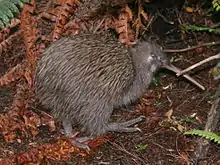Yellow-crowned parakeet
The yellow-crowned parakeet (Cyanoramphus auriceps) also known as the yellow-fronted parakeet is a species of parakeet endemic to the islands of New Zealand. The species is found across the main three islands of New Zealand, North Island, South Island and Stewart Island/Rakiura, as well as on the subantarctic Auckland Islands. It has declined due to predation from introduced species such as stoats, although unlike the red-crowned parakeet, it has not been extirpated from the mainland of New Zealand. Its Māori name is kākāriki.
| Yellow-crowned parakeet | |
|---|---|
 | |
| In captivity | |
| Scientific classification | |
| Domain: | Eukaryota |
| Kingdom: | Animalia |
| Phylum: | Chordata |
| Clade: | Dinosauria |
| Class: | Aves |
| Order: | Psittaciformes |
| Family: | Psittaculidae |
| Genus: | Cyanoramphus |
| Species: | C. auriceps |
| Binomial name | |
| Cyanoramphus auriceps (Kuhl, 1820) | |
History
The yellow-crowned parakeet was once widely distributed across all of New Zealand, both the main islands and the outlying ones. However, due to both the aforementioned introduced mammals and human destruction of habitat, these parakeets have become much scarcer in the last few decades. While uncommon, they are still the most common parakeet in New Zealand.
Taxonomy
This species was first described by Heinrich Kuhl in 1820 and originally named Psittacus auriceps.[3]
Description

Yellow-crowned parakeets are 23 cm long and primarily bright green. They have a red band fronting their eponymous golden crown. Their wings, when spread in flight, are bluish purple. Their eyes are either orange or red and their bill is grey.
The males of this species are larger than the females. The females can also be distinguished from males as their bills are disproportionally smaller.[4]
Range and habitat
Yellow-crowned parakeets prefer the upper canopies of tall, unbroken stub and forest, though they have been observed at high-altitude tussock meadows and on some of the subantarctic islands. A notably favoured habitat is mixed podocarp/nothofagus forest.[5] The preference of C. auriceps for the upper canopies may have placed it at an advantage in comparison to the red-crowned parakeet, as it likely reduced the risk from predators.[6]
These parakeets are endemic to New Zealand and range across the main islands, as well as Ewing Island in the Auckland Islands. This is the world's most southern observed location of Cyanoramphus, and the second-southernmost location of living parrots.[5]
Diet
Yellow-crowned parakeets subsist on the seeds of beech, flax, and tussock, but also eat fruits, flowers, leaves, shoots, and invertebrates.[5]
Reproduction
These birds build nests in crevices, burrows, and trunks of trees depending on the habitat. Their eggs are white.[5]
Conservation
The yellow-crowned parakeet is absolutely protected under New Zealand's Wildlife Act 1953.[7] The species is also listed under Appendix II of the Convention on International Trade in Endangered Species of Wild Fauna and Flora (CITES) meaning international export/import (including parts and derivatives) is regulated.[8]
References
- BirdLife International (2016). "Cyanoramphus auriceps". IUCN Red List of Threatened Species. 2016: e.T22685175A93061596. doi:10.2305/IUCN.UK.2016-3.RLTS.T22685175A93061596.en. Retrieved 12 November 2021.
- "Appendices | CITES". cites.org. Retrieved 2022-01-14.
- Kuhl, Heinrich (1820). Conspectus Psittacorum. Bonn: s.n. p. 46. doi:10.5962/bhl.title.53420. Retrieved 24 June 2016.
- Elliott, Graeme P.; Dilks, Peter J.; O'Donnell, Colin F.J. (January 1996). "The ecology of yellow‐crowned parakeets (Cyanoramphus auriceps) in Nothofagus forest in Fiordland, New Zealand". New Zealand Journal of Zoology. 23 (3): 249–265. doi:10.1080/03014223.1996.9518084.
- "Yellow-crowned parakeet". www.terranature.org. TerraNature Trust. Retrieved 24 June 2016.
- Kearvell, Jonathan C.; Young, James R.; Grant, Andrew D. (2002). "Comparative ecology of sympatric orange-fronted parakeets (Cyanoramphus malherbi) and yellow-crowned parakeets (C. auriceps), South Island, New Zealand" (PDF). New Zealand Journal of Ecology. 26 (2): 139–148. Retrieved 24 June 2016.
- "Wildlife Act 1953". New Zealand Legislation. Parliamentary Counsel Office. Retrieved 18 January 2022.
- "Appendices | CITES". cites.org. Retrieved 2022-01-14.

